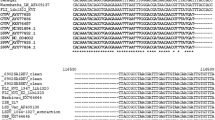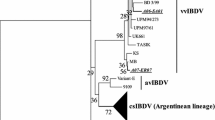Abstract
During the last bovine vaccinia (BV) outbreaks, several Vaccinia virus (VACV) strains were isolated and characterised, revealing significant polymorphisms between strains, even within conserved genes. Although the epidemiology of VACV has been studied in BV outbreaks, there is little data about the circulation of the Brazilian VACV isolates. This study describes the genetic and biological characterisation of two VACV isolates, Pelotas 1 virus (P1V) and Pelotas 2 virus (P2V), which were obtained concomitantly from a horse affected by severe cutaneous disease. Despite being isolated from the same exanthematic clinical sample, P1V and P2V showed differences in their plaque phenotype and in one-step growth curves. Moreover, P1V and P2V presented distinct virulence profiles in a BALB/c mouse model, as observed with other Brazilian VACV isolates. Sequencing and phylogenetic analysis of four different genes demonstrated that the isolates are segregated in different VACV clusters. Our results raise interesting questions about the diversity of VACV isolates in Brazil.






Similar content being viewed by others
References
Damon I (2007). Poxviridae and their replication. In: Knipe, D. M., Howley, P. M., Griffin, D. E., Lamb, R. A., Martin, M. A., Roizman, B., Straus, S. E., Fields Virology, Raven Press Ltd., New York, pp. 2079–2081.
Tulman ER, Delhon G, Afonso CL, Lu Z, Zsak L, Sandybaev NT, Kerembekova UZ, Zaitsev VL, Kutish GF, Rock DL (2006). Genome of horsepox virus. J Virol. 80(18):9244-58.
Fenner F, Wittek R, Dumbell KR (1989). The orthopoxviruses. Academic Press Inc., San Diego.
Fenner F, Henderson DA, Arita I, Jezek A, Ladnyi ID (1988). Smallpox and its eradication. World Health Organization Press, Geneva.
Damaso CR, Esposito JJ, Condit RC, Moussatche N (2000). An emergent poxvirus from humans and cattle in Rio de Janeiro State: Cantagalo virus may derive from Brazilian smallpox vaccine. Virology. 277:439–49.
Trindade GS, Emerson GL, Carroll DS, Kroon EG, Damon IK (2007). Brazilian Vaccinia virus and their origins. Emerg. Infect. Dis. 13(7): 965-72.
Leite JA, Drumond BP, Trindade GS, Lobato ZI, da Fonseca FG, dos Santos JR, Madureira MC, Guedes MI, Ferreira JM, Bonjardim CA, Ferreira PC, Kroon EG (2005). Passatempo virus, a vaccinia virus strain, Brazil. Emerg. Infect. Dis. 11:1935–8.
Trindade GS, Guedes MI C, Drumond BP, Mota BEF, Abrahão JS, Lobato ZIP, Gomes JAS, Corrêa-Oliveira R, Nogueira ML, Kroon EG, da Fonseca FG (2009). Zoonotic vaccinia virus: clinical and immunological characteristics in a naturally infected patient. Clin. Infect. Dis. 48(3):37-40.
Drumond BP, Leite JA, da Fonseca FG, Bonjardim CA, Ferreira PC, Kroon EG (2008). Brazilian Vaccinia virus strains are genetically divergent and differ from the Lister vaccine strain. Microbes Infect. 10(2):185-97
Osborne JD, Da Silva M, Frace AM, Sammons SA, Olsen-Rasmussen M, Upton C, Buller RM, Chen N, Feng Z, Roper RL, Liu J, Pougatcheva S, Chen W, Wohlhueter RM, Esposito JJ (2007). Genomic differences of Vaccinia virus clones from Dryvax smallpox vaccine: the Dryvax-like ACAM2000 and the mouse neurovirulent Clone-3. Vaccine. 25(52):8807-32.
Brum MCS, dos Anjos BL, Nogueira CEW, Amaral LA, Weiblen R, Flores EF (2010). An outbreak of orthopoxvirus-associated disease in horses in southern Brazil. J. Vet. Diagn. Invest. 22(1):143-7.
Joklik W. K. (1962). The purification of four strains of poxvirus. Virology. 18:9–18.
Ferreira JM, Drumond BP, Guedes MI, Pascoal-Xavier MA, Almeida-Leite CM, Arantes RM, Mota BE, Abrahão JS, Alves PA, Oliveira FM, Ferreira PC, Bonjardim CA, Lobato ZI, Kroon EG (2008). Virulence in Murine Model Shows the Existence of Two Distinct Populations of Brazilian Vaccinia virus Strains. PLoS ONE. 3(8):e3043.
Trindade GS, Lobato ZIP, Drumond BP, Leite JA, Trigueiro RC, Guedes MI, da Fonseca FG, dos Santos JR, Bonjardim CA, Ferreira PC, Kroon EG (2006). Isolation of two vaccinia virus strains from a single BV outbreak in rural area from Brazil: implications on the emergence of zoonotic orthopoxviruses. Am J. Trop. Med. Hyg. 75: 486–90.
Sambrook J, Fritsch EF, Maniatis T (1989). Molecular cloning: a laboratory manual. Cold Spring Harbor Laboratory Press, New York, 2nd edn, pp. E.3-E.4. Edited by C. Nolan, N. Ford, & M. Ferguson.
Ropp SL, Jin Q, Knight JC, Massung RF, Esposito JJ (1995). PCR strategy for identification and differentiation of small pox and other orthopoxviruses. J Clin Microbiol. 33(8):2069-76.
Marques JT, Trindade GS, da Fonseca FG, dos Santos JR, Bonjardim CA, Ferreira PCP, Kroon EG (2001). Characterization of ATI, TK and IFN-alpha/betaR genes in the genome of the BeAn 58058 virus, a naturally attenuated wild Orthopoxvirus. Virus Genes. 23(3):291-301.
Marques JT, Trindade GD, Da Fonseca FG, Dos Santos JR, Bonjardim CA, Ferreira PC, Kroon EG (2006). Isolation of two Vaccinia virus strains from a single bovine Vaccinia outbreak in rural area from Brazil: implications on the emergence of zoonotic orthopoxviruses. Am. J. Trop. Med. Hyg. 75(3):486-90.
Drumond BP, Leite JA, da Fonseca FG, Bonjardim CA, Ferreira PC, Kroon EG (2008). Brazilian Vaccinia virus strains are genetically divergent and differ from the Lister vaccine strain. Microbes Infect. 10(2):185-97
de Souza Trindade G, Li Y, Olson VA, Emerson G, Regnery RL, da Fonseca FG, Kroon EG, Damon I (2008). Real-time PCR assay to identify variants of Vaccinia virus: Implications for the diagnosis of bovine vaccinia in Brazil. J Virol Methods. 152(1-2):63-71.
Abrahão JS, Guedes MI, Trindade GS, Fonseca FG, Campos RK, Mota BF, Lobato ZI, Silva-Fernandes AT, Rodrigues GO, Lima LS, Ferreira PC, Bonjardim CA, Kroon EG (2009). One more piece in the VACV ecological puzzle: could peridomestic rodents be the link between wildlife and bovine vaccinia outbreaks in Brazil? PLoS One. 4(10):e7428.
Abrahão JS, Silva-Fernandes AT, Assis FL, Guedes MI, Drumond BP, Leite JA, Coelho LF, Turrini F, Fonseca FG, Lobato ZI, Madureira M, Ferreira PC, Bonjardim CA, Trindade GS, Kroon EG (2010). Human Vaccinia virus and Pseudocowpox virus co-infection: clinical description and phylogenetic characterization. J Clin Virol. 48(1):69-72.
Grivel J, Ito Y, Fagà G, Santoro F, Shaheen F, Malnati MS, Fitzgerald W, Lusso P, Margolis L (2001). Suppression of CCR5- but not CXCR4-tropic HIV-1 in lymphoid tissue by human herpesvirus 6. Nat. Med. 7:1232-1235.
Xiang J, Wunschmann S, Diekema DJ, Klinzman D, Patrick KD, George SL, Stapleton JT (2001) Effect of Co-infection with GB Virus C on Survival among Patients with HIV Infection. N. Engl. J. Med. 345:707-714.
Barton ES, White DW, Cathelyn JS, Brett-McClellan KA, Engle M, Diamond MS, Miller VL, Virgin HW, (2007) Herpesvirus latency confers symbiotic protection from bacterial infection. Nature. 447: 326-329.
Carrillo FY, Sanjuán R, Moya A, Cuevas JM (2007). The effect of co- and superinfection on the adaptive dynamics of vesicular stomatitis virus. Infect. Genet. Evol. 7(1): 69-73.
Dasgupta A, Hammarlund E, Slifka MK, Früh K (2007). Cowpox virus evades CTL recognition and inhibits the intracellular transport of MHC class I molecules. J. Immunol. 178(3): 1654-61.
Lisco A, Grivel J, Biancotto A, Vanpouille C, Origgi F, Malnati MS, Schols D, Lusso P, Margolis LB (2007). Viral Interactions in Human Lymphoid Tissue: Human Herpesvirus 7 Suppresses the Replication of CCR5-Tropic Human Immunodeficiency Virus Type 1 via CD4 Modulation. J. Virol. 81(2):708-717.
Carrillo FY, Sanjuán R, Moya A, Cuevas JM (2008) Enhanced adaptation of vesicular stomatitis virus in cells infected with vaccinia virus. Infect Genet Evol. 8(5):614-20.
Stapleton JT, Chaloner K, Zhang J, Klinzman D, Souza IE, Xiang J, Landay A, Fahey J, Pollard R, Mitsuyasu R (2009). GBV-C viremia is associated with reduced CD4 expansion in HIV-infected people receiving HAART and interleukin-2 therapy. AIDS. 23(5):605-10.
Katz E, Margalith E, Winer B, Lazar A (1973). Characterization and mixed infections of three strains of Vaccinia virus: Wild type, IBT-resistant and IBT-dependant mutants. J. Gen. Virol. 21:469-475.
Doceul V, Hollinshead M, van der Linden L, Smith GL (2010). Repulsion of superinfecting virions: a mechanism for rapid virus spread. Science. 327(5967):873-6.
Zhang WH, Wilcock D, Smith GL (2000). Vaccinia virus F12L protein is required for actin tail formation, normal plaque size, and virulence. J Virol. 74(24):11654-62.
Acknowledgements
We thank João Rodrigues dos Santos, Ângela Sana Lopes, Ilda Gama and colleagues from the Laboratório de Vírus for their invaluable technical support.
Financial support was provided by the Conselho Nacional de Desenvolvimento Científico e Tecnológico (CNPq), the Coordenação de Aperfeiçoamento de Pessoal de Nível Superior (CAPES) and the Fundação de Amparo à Pesquisa do Estado de Minas Gerais (FAPEMIG), Ministério da Agricultura, Pecuária e Abastecimento (MAPA). The study sponsors had no involvement in the study design, the collection, analysis and interpretation of data, the writing of the manuscript, or the decision to submit the manuscript for publication.
Conflict of interest statement
“None of the authors of this paper has a financial or personal relationship with other people or organisations that could inappropriately influence or bias the content of the paper.”
Author information
Authors and Affiliations
Corresponding author
Rights and permissions
About this article
Cite this article
Campos, R.K., Brum, M.C.S., Nogueira, C.E.W. et al. Assessing the variability of Brazilian Vaccinia virus isolates from a horse exanthematic lesion: coinfection with distinct viruses. Arch Virol 156, 275–283 (2011). https://doi.org/10.1007/s00705-010-0857-z
Received:
Accepted:
Published:
Issue Date:
DOI: https://doi.org/10.1007/s00705-010-0857-z




